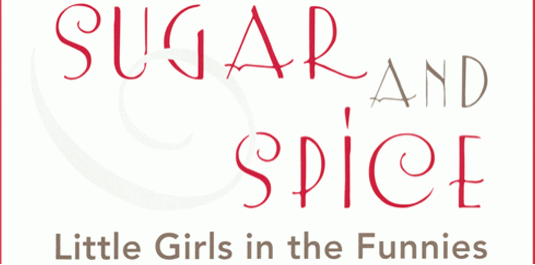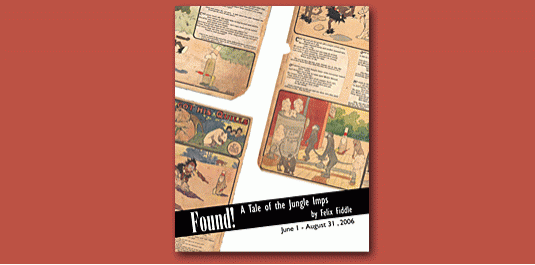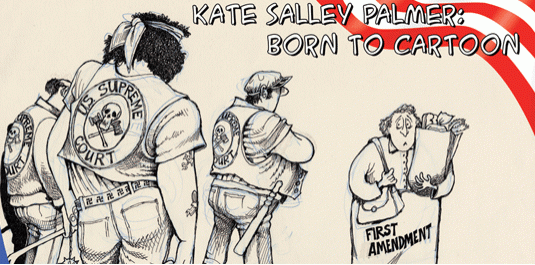Past Exhibits
 Korean Comics: A Society Through Small Frames January 16, 2007 - March 16, 2007
Korean Comics: A Society Through Small Frames January 16, 2007 - March 16, 2007 The sleek lines and sci-fi plots of Japanese anime have generated a large following, but until now, few comics connoisseurs have known about Korean cartoons. No more. The Korea Society presents Korean Comics: A Society Through Small Frames, the first substantial survey of Korean comics to be exhibited in the U.S.
The exhibition features 83 framed works by 21 of Korea’s most talented cartoonists, drawn over a period of 40 years. It includes work by artists from both South Korea and North Korea.
 Sugar & Spice: Little Girls in the Funnies September 18, 2006 - December 29, 2006
Sugar & Spice: Little Girls in the Funnies September 18, 2006 - December 29, 2006 The second day of Peanuts featured Patty happily walking down a sidewalk reciting the familiar nursery rhyme, “What are little girls made of? Sugar and spice, and everything nice…” She meets Charlie Brown, smacks him in the face, and continues her verse, “That’s what little girls are made of!” Charles Schulz knew about little girls because he was the father of three of them. Once when he was asked if Peanuts was based his children, he replied that the strip was based on memory, not observation. Schulz used the wellspring of his memory to create the repertory company of Peanuts characters that included little girls with realistic personalities. As in several other aspects of the history of the American comic strip, Charles Schulz was innovative and influential in the type of little girl characters he conceived; and as a result of his innovation, post-Peanuts comic strips feature different types of girl characters.
Sugar and Spice is a sampling of girl characters who are comic strip protagonists, girls who are sidekicks of leading boy characters, and comics families with daughters. How girls were depicted in comic strips before and after Schulz created the Peanuts girls is the question asked by the exhibit. The Charles M. Schulz Museum and Research Center hosted this exhibition from February 2 through June 30, 2006. The exhibit was guest-curated by Lucy Shelton Caswell, professor and curator of Ohio State University’s Cartoon Research Library.
 A Tale of the Jungle Imps by Felix Fiddle June 1, 2006 - August 31, 2006
A Tale of the Jungle Imps by Felix Fiddle June 1, 2006 - August 31, 2006 It was an Antiques Roadshow experience: In early January, a stranger called The Ohio State University Cartoon Research Library to say that she had found some old cartoons tucked in a stack of boxes that had been sitting in her family’s business for decades. She wanted to know if they were valuable. Lucy Shelton Caswell, Professor and Curator of the library, was skeptical since she often receives calls from people who have found items in grandma’s attic that end up having only sentimental value. The caller was insistent however, and said she was near to campus and would like to bring her find to the library for Caswell to see. An appointment was made for the next afternoon. The caller arrived with a battered cardboard folio. When it was opened, Caswell knew that this time a treasure had been uncovered. Inside were original, hand-colored drawings from Winsor McCay’s first comic strip,A Tale of the Jungle Imps by Felix Fiddle. Up to that moment, no original drawings of the strip were known to exist.
Best known for his comic strip Little Nemo in Slumberland, McCay has been described variously as “the first authentic genius in the comic strip medium,” “one of American’s rare, great fantasists,” and a cartoonist for whom there has been “no equal before or since.” During the 1890s McCay worked as an artist for the Vine Street Dime Museum and Palace Theater in Cincinnati. In 1900 he joined the staff of the Cincinnati Enquirer as an artist/reporter. In 1903 he created forty-three episodes of A Tale of the Jungle Imps by Felix Fiddle , illustrated stories about pixies and the imaginary animals they encounter that were printed full-page in color. McCay’s biographer John Canemaker notes the importance of this “proto-comic strip” for McCay: “Tales of the Jungle Imps was Winsor McCay’s first attempt in an extended series format to bring together all of his eclectic talents in a cohesive graphic style. On each page, he found fresh ways to combine his exquisite draftsmanship, dynamic staging, sense of caricature, mastery of perspective, and feeling for motion with his version of the decorative art nouveau style.” Until January 2006 none of the original drawings created by McCay had been seen for more than a century.
 Kate Salley Palmer: Born to Cartoon January 25, 2006 - April 14, 2006
Kate Salley Palmer: Born to Cartoon January 25, 2006 - April 14, 2006 Kate Salley Palmer: Born to Cartoon is an exhibition of Palmer’s editorial cartoons about national and international issues. She claims that cartoonists are born, not made–and her passion for her art is reflected in her work.
An Orangeburg, South Carolina, native, Kate Salley Palmer graduated from the University of South Carolina with a major in elementary education. She began freelance cartooning with the Greenville News in 1975 and in 1978 she became their first full-time editorial cartoonist. She was syndicated by Field (later News America Syndicate) in 1980. She left the newspaper in 1984 and moved to Associated Features in 1986. Her syndication ended in 1989, after which she has devoted her efforts to writing and illustrating children’s books.
 The Yellow Kid: Hero of Hogan's Alley September 15, 2005 - January 13, 2006
The Yellow Kid: Hero of Hogan's Alley September 15, 2005 - January 13, 2006 The Yellow Kid has been described as the first comic strip superstar. His popularity was so enormous that the great rival newspapers in New York City, Joseph Pulitzer’s New York World and William Randolph Hearst’s New York Journal, at one time ran competing versions of the Yellow Kid drawn by two cartoonists. The Kid was successfully merchandised by a wide range of products from cigarettes and game cards to dolls and sheet music.
Richard Felton Outcault (1863-1928) created the comic strip Hogan’s Alley, which is considered to be the first significant comic strip in American newspapers. It debuted in 1895 and featured Mickey Dugan, who is better known as the Yellow Kid.
This exhibition features rare examples of original full-color newspaper pages featuring the Yellow Kid from the San Francisco Academy of Comic Art Collection

